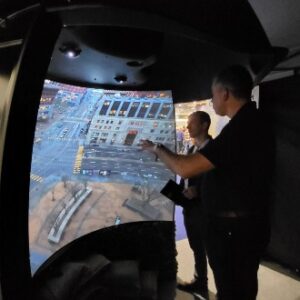In a time of extreme crisis, videoconferencing and unified communication and collaboration tools have already reshaped our post-pandemic work environment
How the COVID-19 pandemic remade the world will be a one of the most examined and written about global events in history. With virtually every aspect of human life disrupted in hopes of containing the coronavirus until a vaccine is found, the way we work, play and even sleep has been redefined.
For longtime work-from-home advocates, the pandemic has justified and reinforced several of their key arguments, including the fact that most people are more productive when working from home. The pandemic’s forced confinement has also turned many of us into videoconferencing and unified communications and collaboration experts, having to immediately get to grips with platforms like Zoom and Microsoft Teams in a relatively short period of time.
“What many industry analysts and experts have been saying is that our society has experienced 20 years of digital transformation in one month,” says David Danto, director of emerging technology at IMCCA (Interactive Multimedia & Collaborative Communications Alliance). “With no choice to say no, knowledge workers have migrated to unified communications to remain engaged with their employers, and those employers have put their faith in these tools. What we’ve all discovered is that, with very minor exceptions, remote collaboration works as well as many of us have been saying for many years. The naysayers that preached against remote working have been finally and irrevocably proven wrong. People are generally more productive than when they had to commute to and from an office every day. This will forever change the definition of work, with non-essential commuting being significantly reduced well after the pandemic passes, and many people only traveling when they have to be somewhere, like to attend a meeting or project site or event.”
Danto is not alone in predicting that the current shift in work from home practices is a permanent change to not only how we work, but also to workspace dynamics and construction. Carl Wiese, executive vice president and chief revenue officer at Poly, says it will be difficult to “put the genie back into the bottle” as people grow accustom to work-from-home practices and remote interactions.
“When employees eventually return to the office and are seated in a conference room — or join a conference or video call — they’re going to expect the same flexible and seamless technology they have experienced from home,” Wiese says. “For those who continue to work from home for longer stints and have been making do with off-the-shelf tools as a stop gap, I anticipate a second wave of device purchases as they opt to upgrade their remote tools to true integrated devices.”
For integrators like Matt Slack, president of AV Solutions — who observes that popular videoconferencing and UC tools have seen dramatic improvement in addressing quality, bugs and adding new features to accommodate demand and security concerns — a key issue is “that there are many different user and buyer groups with different needs, motivations and budgets. Over time, platforms will arise, divide, and adjust to follow the demand of particular crowds. For instance, Microsoft Teams already had a growing audience (business organizations with existing Microsoft Licensing in place). I don’t believe that will shift very much. On the other hand, Zoom has received massive use by end-users, families, and social groups because of its accessibility. Will Zoom shift to cater to this market? Will they focus on business and enterprise organizations? Will they do both?”
Is Further Convergence Possible?
There has been a lot of talk in the AV integration business about deeper convergence between videoconferencing and UCC. The pandemic and the subsequent demand for both streams to more efficiently come together has been accelerated, but significant challenges remain even as big players in the channel say things are on track for greater interplay.
“While demand may continue to drive development, there are substantial infrastructure and incentive challenges that will keep some level of VC/UCC more divided than the world would like to see,” Slack says. “For instance, both Zoom and Teams are on non-standard codecs making integration between existing enterprise platforms difficult, costly, and in a lot of cases, impossible. ‘Solutions’ exist for this, but they aren’t cheap because they have to continually evolve to stay in sync with development on a single platform. Furthermore, most of the solutions are priced for businesses and offered in ‘per connection’ or ‘per instance’ formats. Both attributes severely hinder the level of cross-platform communication necessary for further integration of VC/UC that would quickly be welcomed and adopted by organizations of all types.”
Slack believes that, ultimately, consumer product channels will adapt to bring true VC/UCC interaction to end users for free, while enterprise VC/UCC will remain fragmented until the major platforms standardize to allow for low-cost ubiquitous cross-platform connections.
“For the portions of companies that are outward facing like business development or client services, it becomes more complicated because those groups need compatibility, which is largely defunct between SIP/H.323, Zoom, Teams and WebX,” Slack explains. “The compatibility that does exist between portions of these services, including Pexip, is costly with a lot of ‘rules’ about what can or can’t be done. This poses a significant blockade to further market adoption. At its core, it is the non-standardization which leads to high development and maintenance costs and complexity.”
Some companies in the AV channel believe that in spite of impediments, full convergence is clearly on track. Weise notes that on top of devices for productivity and connectivity, chief information officers and IT decision makers are trying to provide the tools to foster interactions that allow for human connection, while newer players in the field like T1V lead by Mike Feldman are creating agnostic platforms to remove barriers to comprehensive VC/UCC interaction.
“In our space — visual collaboration — we have already seen this convergence. This is why we made a decision years ago to ensure that our ThinkHub collaboration platform was completely agnostic to support multiple video conferencing options,” Feldman says. “Video conferencing tools are slowly beginning to weave what we would consider ‘UCC’ features into their products — the ability to annotate, the ability to share device screens. What they lack is a shared workspace, where teams can share and visualize large amounts of content at the same time. They also lack the interactivity of a native touch experience, while some support single touch, this does not deliver the same experience as a multitouch, multiuser environment.”
What’s in Demand
With demand for VC and UCC tools skyrocketing, end users are putting together solutions that work best for them. Andrew Gross, Crestron’s director of sales, UC Enterprise, says that VC and UCC tools are solving the soft skills hole — reading body language, listening, or taking social cues — that was widen by the pandemic when the workforce transitioned to work from home.
“Even more, these tools are allowing people to continue to engage with customers, partners, and colleagues effectively and efficiently and safely,” Gross says.” To add on, videoconferencing and UCC have shaped into a “stand-in” for the loss of our everyday personal interactions, such as happy hours, dinners with friends, colleagues, or even customers. A “virtual customer happy hour” cannot just be a phone call — only videoconferencing could enable that!”
Slack notes that Zoom has smartly moved in the small room space via third-party hardware from Crestron and Poly yet fails to deliver a high-resolution video experience for business leaders, but it still wins the day because it is the most accessible and feature-rich of the platforms.
“Most of the market isn’t used to high-quality video, so Zoom’s low-quality video isn’t yet noticed,” Slack says. “I expect Zoom will scale their quality up over time to keep up with expectations. Zoom also has terrible bandwidth utilization, but no one’s noticed yet. Enterprises will.”
Poly reports that there is a high demand for its UC-compatible wireless Bluetooth adaptive noise-cancelling headsets, like Voyager 8200 UC, while its HD videoconferencing cameras like the Eagle Eye Mini, which adds business-class HD video to computers, are seeing an uptick.
“We’ve even continued to see high demand for plug-and-play video devices like Poly Studio and Poly Studio X30 video bars which can be managed through the cloud and are compatible with popular video-as-a-service (VaaS) solutions like Microsoft Teams, Skype for Business, Zoom, Google Meet, Cisco WebEx and Amazon Chime,” Weise adds.
TV1’s ThinkHub collaboration software is in line with what Feldman calls “hybrid tools” that provide a great experience for both in-room and remote participants.
“Post-pandemic, video conferencing will now be a minimum requirement for all office meeting rooms; it’s inevitable teams will have at least one remote participant per meeting,” Feldman says. “This will be the biggest opportunity post- COVID-19: making sure we provide the remote employees as good an experience as their in-office colleagues. In late 2019, we developed a simple collaboration board, HubVC, that would support multiple VC options (Zoom, Webex, Teams), plus wireless screen sharing and whiteboarding. It’s affordable enough that it could go in every meeting room, and even home offices, where a huge amount of IT budget will be reallocated, to support remote employees, and to ensure their home/work experience is as productive as the in-office experience.”
Uniquely, Collaboration Squared, a relatively new player in the channel, has built its Video Window Remote VC/UCC solution from an in-office group perspective as part of creating better mental health dynamics in the workplace.
“The office landscape is going to change significantly with social distancing methods meaning there will be a much larger mix of office-based versus remote-based employees, or additional temporary regional office spaces that will need to be rented to cater for the minimizing of commuting and social distancing measures, a “hub and spoke” strategy,” says Daryl Hutchings, co-founder and CEO of Collaboration Squared. “With that traditional video conferencing technologies just can’t solve the problem here and why use case specific products like Video Window exists to help office employees and remote employees feel like it’s an extension of physical space to see each other throughout the day and also have ad hoc side conversations that don’t interrupt the entire group. I hope we’ll continue to see lots more innovation in the UCC space. Now is the time.”
VC/UCC’s Post-Pandemic Future
Weise’s observation that it will be hard to put the VC/UCC genie back into the bottle as we emerge from the COVID-19 lockdown underscores the leaps and bounds the product segment has made since the beginning of 2020. With all of us equipped, to varying degrees, with VC/UCC knowledge, software and hardware, the logical next step is to not only upgrade those products and that knowledge but to demand even more capabilities from them as we settle into a new way of working, either in socially distancing offices or from newly built home-office spaces.
“The first theme is accommodating to social-distancing guidelines as we transition back into the office. We are seeing that enterprises are cutting the max capacity of their conference rooms in half to accommodate to pandemic guidelines,” Gross says. “With smaller capacity conference rooms, organizations are turning to their non-traditional spaces, such as lobbies or hallway, to host larger meetings. Enterprises will still need the right equipment to host calls so non-permanent conferencing tools will be introduced into the office. These tools can be moved around and installed easily.”
Gross also highlights the evolutions touch will undergo in the office environment, with companies likely moving toward collaboration systems that require your personal device, eliminating the need to use the conference room touch panel. “Touch screens of the future will also feature antimicrobial glass, as it will stop the growth of bacteria. Also, instead of using a touch panel to signal that a conference room is in use, motion sensor technology will be used to book meeting rooms,” Gross adds.
The rise of immersive products and collaboration tools specific to verticals such as telehealth and online education will as get a boost, notes Weise, who points to the increased need for all-in-one solutions tailored to teachers and students.
“Products are consumer-oriented at the moment but will need to be created with specific industries in mind to address these demands,” Weise says. “If there were ever a time to think outside of the office building, it’s now. It’s a difficult period and resources are limited, but it’s important to carve out time to envision the future and use this time to inspire your teams to get there.”









